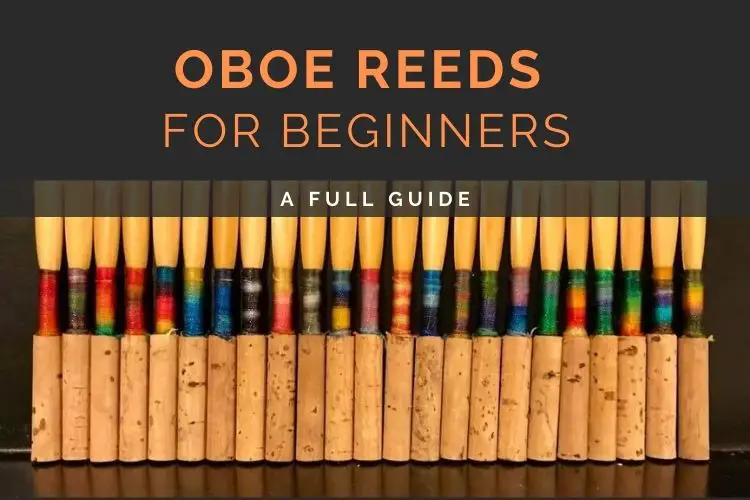If you or your child is just starting to play the oboe, you likely have quite a few questions about oboe reeds.
You’ve probably already noticed that they are significantly different from a clarinet or saxophone reeds, which you are more than likely already used to. It’s easy to feel overwhelmed by all the unknowns:
- How expensive are oboe reeds?
- How long do they last?
- Which type of reed is best to start out with?
- How many reeds will I need in the beginning?
Fortunately, we have the answers to all these questions and more.
Read on to learn more about the best types of oboe reeds for beginners and students, as well as how to care for them.
What Type of Reed is Best for Beginner or Student Oboists?
The type of reed you choose to buy as a beginner oboist is just as important as the type of instrument you purchase.
When you go to purchase your first student oboe reeds, you’ll likely encounter reeds of different “hardness levels.”
At your local music store or online, you will see soft, medium soft, medium, and hard reeds. These refer to the strength of the wood, with harder reeds having more resistance and will require you to have a stronger embouchure and better breath support.
Beginner oboists would likely do better with a soft or medium soft strength reed, as these will have little resistance and will help you or your young oboist to develop their breath support before advancing in reed strength.
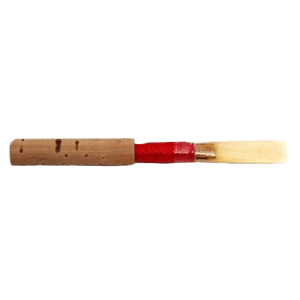
As you progress, however, you will want to gradually increase your reed strength. This is because you will begin to develop better breath support, and softer reeds will not be able to handle your stronger playing. If you attempt to continue using a reed that is too soft, you may find that your sound suddenly cuts out while you are playing. Once this occurs, you will know you are ready to progress to a harder reed.
How Long do Oboe Reeds Last?
Unfortunately, there is no hard or fast rule as to how long a reed will last.
This will vary significantly based on the quality of the reed, the amount of time you spend playing each day, and how well you take care of your reeds.
Factors Influencing How Long a Oboe Reed Will Last
Of course, the less you use them and the better you care for them, the longer they will last.
However, unlike reeds for clarinets and saxophones, oboe reeds are extremely delicate and fragile. They respond poorly to stress, temperature changes, and extreme wetness or dryness. It is almost too easy to damage or break your oboe reed.
Other activities may impact the longevity of the reeds as well. The frequency and duration of soaking that you put them through can affect their lifespan. Generally, you should never allow your oboe reed to soak in water for more than two to three minutes at a time, as this will cause the reed to lose its vibration faster and tire it out, so to speak. Additionally, you should make sure that the water is room temperature, and neither too hot nor too cold.
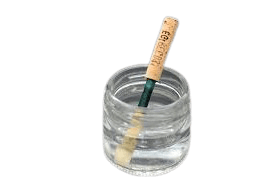
The way you store your reeds can affect their longevity as well. To ensure they last as long as possible, you will need to store your oboe reeds in an oboe reed case that will allow them to be securely fashioned in place. If they are loose or allowed to roll around in the case, they are likely to be damaged. To ensure that they last as long as possible, keep three to four reeds on hand at any given time, and rotate through these every few days. If they are rotated and properly cared for, you may only need to replace your set of reeds every four to six weeks.
How Important is a Reed Case?
Unless you’re practically made of money, investing in a high-quality reed case is incredibly important.
The costs involved in continually replacing your reeds can add up to become a major expense and can be reduced when stored correctly.
You will want to invest in a case that will hold your reeds in place securely so that they do not roll around and has extra padding along the inside in case they do. If they are allowed to move around freely within an improperly padded box, they will very quickly become chipped and/or cracked.
Beginners will do best with an inexpensive, well-padded reed case that can securely hold around three or four reeds. As you begin collecting more reeds, you may choose to purchase larger cases.
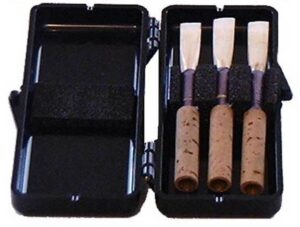
Cases come in all styles and colors and are generally considered very personal to oboists. However, you’ll want to place more of an emphasis on finding a case that is healthiest for your reeds and worry about design second.
How Many Reeds Does a Beginner Oboe Player Need?
At any given time, a beginning oboe player will need to keep around three to four reeds on hand.
As you become a better player, you will be able to increase the number of reeds you carry around with you, but for now, 3-4 is fine.
When Should a Beginner Oboist Replace their Reeds?
Over time, you will need to replace the 3 to 4 oboe reeds, as they will deteriorate from use and general wear and tear. If you are rotating through them every few days and taking good care of them, you can expect to replace them every 4-6 weeks; however, if you play daily and for significant lengths each day, you may need to replace them more frequently than this.
How Much Does an Oboe Reed Cost?
Oboe reeds are significantly more expensive than other types of reeds.
For example, a box of 10 clarinet reeds may cost less than $20. However, a single oboe reed may cost between $15 and $30.
Additionally, they will need to be replaced more frequently than other types of reeds – and these costs may add up.
Average Yearly Expenses of Oboe Reeds for a Student
If you rotate through 3 reeds at a time and replace them every five weeks, this means you may spend on average $702 a year on oboe reeds alone. And this cost may be even higher if you are playing more frequently, or if you do not take care of your reeds as well as you should.
To reduce the amount you spend on oboe reeds, it is important to take care of your reeds by not soaking them too long, keeping them away from extreme temperatures, rotating through them every few days, and storing them in a suitable case.
Additionally, certain types of reeds will be more expensive than others. Harder, sturdier reeds will cost more than soft, beginner oboe reeds, and you will pay more for a higher-quality hand-manufactured reed than you would for one that has been manufactured in a factory.
How do Oboe Reeds Differ from Other Woodwind Reeds?
- For starters, the oboe is a double reed instrument, meaning it uses different reeds than other types of woodwind instruments, such as clarinets or saxophones, which use single reeds. A “single reed instrument” means that the instrument uses a reed that is composed of a single piece of carved cane wood that vibrates against the mouthpiece of the instrument. Double reeds, on the other hand, have two pieces of wood that vibrate against each other.
- Oboe reeds are a bit different from other reeds regarding their care and usage. For starters, you can stick clarinet and saxophone reeds in your mouth for a short period of time, and then be able to play with them. However, oboe reeds must be fully soaked in water for around two to three minutes before they are playable.
- You also must purchase oboe reeds individually, while other types of reeds are often sold in packs.
- They are more fragile than reeds for single reed instruments
- Are damaged easier and need to be replaced more frequently.
- As such, they are also much more expensive than reeds for single reed instruments.
Which is Better: Hand-Manufactured or Machine-Manufactured Reeds?
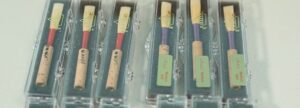
In general, hand-manufactured reeds are overall better than machine-manufactured reeds.
Hand-Manufactured Oboe Reeds
Hand-manufactured oboe reeds have been crafted with time, energy, and care, and have been repeatedly tested and adjusted until they can produce a near-perfect sound.
They are generally produced by expert oboists who have been crafting reeds for years and know exactly what one should sound like.
Machine-Manufactured Oboe Reeds
In contrast, machine-manufactured reeds are generally mass-produced, not tested, and may not suit all oboists equally.
However, as they are produced more easily, machine-manufactured reeds are significantly cheaper than hand-manufactured reeds. Therefore, if you’re a beginner trying out the oboe for the first time, you may prefer to start with a machine-manufactured reed, and then progress to a more professional-sounding reed in time.
Everything You Need to Know About Making Your Own Reeds
If you want to go all out, the absolute best way to go about obtaining a reed is to make your own. This is because different reeds “fit” different people in different ways.
By crafting your reeds, you will be able to ensure that your reed is perfectly customized to suit your needs.
Important Note: This is not a skill that you will be able to pick up on overnight and requires significant practice and dedication to hone the skill.Learning to Make Your Own Oboe Reeds
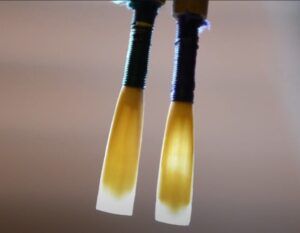
If you want to begin learning how to make your reeds, the best route to go is by learning from someone in person who is already skilled at the activity.
Likely, your teacher or private instructor can let you know when you’re ready, as you will need to have a firm grasp on how to produce a good sound, as well as a well-developed embouchure before you can begin.
However, if you believe you are ready, there are also plenty of places online where you can find more information on making your reeds by hand (check our “Resources for Beginners” section below).
Additionally, learning to make reeds may be a serious financial and time commitment, so you should only begin the process if you’re serious about continuing with the oboe for the long term. It will likely take you years of practice before you can produce a good-sounding reed, and it may very well turn into a full-time hobby, leaving little room for other endeavors.
If this is the case for you, though, then making your reeds is by far superior to purchasing even reeds that are made by other oboists.
Resources for Beginners
- Lindabeth Binkley, an oboe professor at Central Michigan University School of Music, provides a parent guide for selecting a beginner oboe, as well as reed making basics, and how to buy and store your reeds. There is a wealth of information surrounding oboes on her site, and these are well worth looking into.
- This YouTube Channel provides video instructions on beginners who are pursuing reed making.
- Double or Nothing Reeds is an oboe reed manufacturer that also provides helpful tips for beginning oboe players.
- Oboe for Everyone is a site that provides access to free lessons, tutorials, as well as links to reed makers and sheet music you can use to practice.
Takeaway on Oboe Reeds for Beginners
In summary, oboe reeds are very different from other types of reeds.
They are more expensive and are more likely to need replacing sooner than other reeds. That’s something to take into account in one of the most expensive band instruments for a beginner.
However, the better you care for your reeds, the longer they will last. Oboe reeds should be soaked in water for no more than two to three minutes at a time and should be stored in a secure, well-padded case when not in use.
For the best sounding reed, you may want to pick up the hobby of learning to make your reeds from scratch.
When in doubt, there are always plenty of resources online you can utilize to help you better understand oboe reeds.

